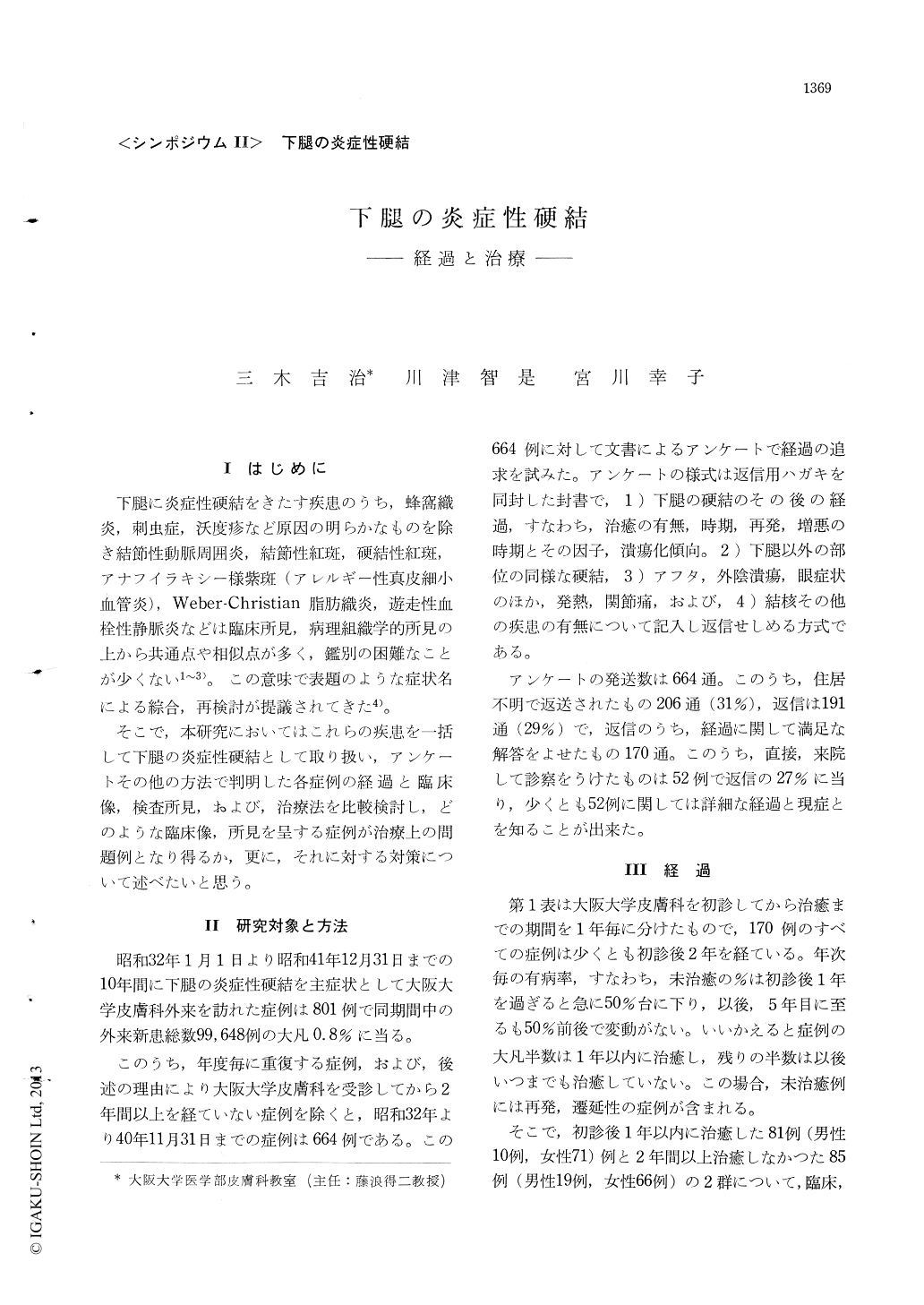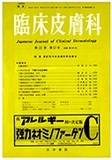Japanese
English
- 有料閲覧
- Abstract 文献概要
- 1ページ目 Look Inside
Iはじめに
下腿に炎症性硬結をきたす疾患のうち,蜂窩織炎,刺虫症,沃度疹など原因の明らかなものを除き結節性動脈周囲炎,結節性紅斑,硬結性紅斑,アナフイラキシー様紫斑(アレルギー性真皮細小血管炎),Weber-Christian脂肪織炎,遊走性血栓性静脈炎などは臨床所見,病理組織学的所見の上から共通点や相似点が多く,鑑別の困難なことが少くない1〜3)。この意味で表題のような症状名による綜合,再検討が提議されてきた4)。
そこで,本研究においてはこれらの疾患を一括して下腿の炎症性硬結として取り扱い,アンケートその他の方法で判明した各症例の経過と臨床像,検査所見,および,治療法を比較検討し,どのような臨床像,所見を呈する症例が治療上の問題例となり得るか,更に,それに対する対策について述べたいと思う。
Literal inquiries were sent to 664 cases of inflammatory lower leg nodules encountered between 1957 and 1965 at the Department of Dermatology, Osaka University. Out of 191 cases who responded to the inquiries, 170 cases gave satisfactory answes concerning the present status of the nodules, presence or absence of aphthous stomatitis, genital ulcers, ocular involvement and pulmonary or other tuberculosis.
The follow-up study showed that 81 out of 170 cases were cured within 1 year after the first visit to the hospital, 4 cases were cured between 1 and 2 years, and 85 cases were not cured even after 2 years. Clinical, histological as well as loboratory data were compared between the 81 transient cases and the 85 protracted rcases. Four indeterminate cases were removed from the study.
The protracted cases showed more disseminated distribution of the inflammatory nodules over the four extremities and more frequent ulceration and pigmentation of the nodules than the transient cases. Varicosities of the lower legs and dilated abdominal veins were observed more frequently in the protracted cases. General symptoms, i.e. hyperpyrexia and althralgia were also more commonly experienced in the protacted cases. Aphthous stomatitis, genital ulcers, uveitis or pustulation following sterile needle punctures were present almost solely and in over 40% of the protracted cases indicating a close relationship with Behçet's syndrome.
The initial clinical diagnoses were: Behçet's syndrome in 18% of the protracted and 1% of the transient cases, erythema nodosum in 6% of the protracted and 16% of the transient cases, and erythema induratum including nodular vasculitis in 70% of both transient and protracted cases.
Histopathology of the nodules were examined in 20 cases respectively in each group and were divided into ( 1) dermal angiitis, (2) epithelioid cell panniculitis, (3) subcutaneous thrombophle-bitis and (4) other nonspecific changes. There were no single predominant features in either group. Other laboratory findings including hematology, urinalysis, blood sedimentation rate, tuberculin reaction, chest roentgenogram, serum protein (Tiselius), ASLO, CRP and RA factors were also compared and there were no particular differences between the courses of the diseaseexcept that albuminuria was definitely more frequent in the protracted cases. Elevated sed-imentation rate and hyper-gamma-globulinemia were observed in high percentages in many cases.
Various treatments and remedies, including sulfa drugs, antibiotics, anti-tuberculous agents, antihistaminics and non-steroid anti-inflammatory agents have been given in both groups of cases. Among those, hospitalization and bed rest with elevated lets or the administration of corticosteroids have proved to be the most effective therapy to reduce the inflammation. However, the recurrences occurred immediately following the discharge from the hospital or the reduction of the dosis of steroids in the protracted cases. Immunosuppressive therapy using oral cyclo-phosphamide 150mg daily was started in cases of Behçet's syndrome with lower leg nodules, and seemed to give a favorable result when combined with systemic steroids.

Copyright © 1968, Igaku-Shoin Ltd. All rights reserved.


